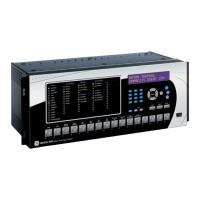5-144 M60 Motor Protection System GE Multilin
5.6 GROUPED ELEMENTS 5 SETTINGS
5
The thermal model is the primary protective function of the relay. It consists of five key functions:
• Thermal model curve (overload).
• Overload pickup level.
• Unbalance biasing of the motor current while the motor is running.
• Motor cooling time constants.
• Biasing of the thermal model based on hot/cold information and/or measured stator temperature.
The algorithm integrates both stator and rotor heating into a single model. The motor heating level is maintained in the ther-
mal capacity used register. If the motor has been stopped for a long time, it will be at ambient temperature and thermal
capacity used will be zero. If the motor is in overload, the output operand is set once the thermal capacity used reaches
100%.
Once the motor load current exceeds the overload level (FLA x overload factor), it enters an overload phase; that is, the
heat accumulation becomes greater than the heat dissipation. The M60 thermal model reacts by incrementing the thermal
capacity used (TCU) at a rate dependent on the selected thermal curve and overload level. When the thermal capacity
reaches 100%, the
MOTOR THERMAL OP operand (typically configured to trip the motor) is set. This operand remains
asserted until TCU decays to the level that permits a new motor start. For additional details, see the description of the
START INHIBIT TCU MARGIN setting in this section.
• THERMAL MODEL CURVE: The thermal model curve determines the thermal limit overload conditions that can dam-
age the motor. This curve accounts for motor heating in both the stator and rotor during stall, acceleration, and running
conditions. The overload curve can take one of six formats: Motor, FlexCurve A, FlexCurve B, FlexCurve C, FlexCurve
D, or IEC. The selected curve can also serve as a base for a voltage dependent overload curve if the
VOLTAGE DEPEN-
DENT FUNCTION
setting is “Enabled”. The algorithm uses memory in the form of a register called Thermal Capacity
Used. This register is updated every power cycle using the following equation:
(EQ 5.7)
where time_to_trip represents the time coordinate on the time-current overload curve, corresponding to the equivalent
motor current detected within any power cycle period of motor overload. Always set the overload curve slightly lower
than the thermal limits provided by the motor manufacturer. This ensures that the motor is tripped before the thermal
limit is reached.
The “Motor” curve is based on typical motor thermal limit curves and is normally used for standard motor applications
(see the Standard Motor Curves figure and Standard Curve Multipliers table below). The pickup level for the “Motor”
curve
is calculated as MOTOR OVERLOAD FACTOR setting (OF) times the MOTOR FULL LOAD AMPS setting (FLA). The
MOTOR FULL LOAD AMPS (FLA) setting can be found in the SYSTEM SETUP MOTOR menu.
MESSAGE
VD STALL CURRENT @
100% V: 6.00 x FLA
Range: 1.50 to 20.00 x FLA in steps of 0.01
MESSAGE
VD SAFE STALL TIME @
100% V: 10.0 sec.
Range: 0.1 to 1000.0 s in steps of 0.1
MESSAGE
VD ACCELL. INTERSECT
@100% V: 5.00 x FLA
Range: 1.50 to 20.00 x FLA in steps of 0.01
MESSAGE
THERMAL MODEL
BLOCK: Off
Range: FlexLogic operand
MESSAGE
THERMAL MODEL
TARGETS: Self-Reset
Range: Self-reset, Latched, Disabled
MESSAGE
THERMAL MODEL
EVENTS: Disabled
Range: Disabled, Enabled
TC
used t
TC
used (t – 1)
1 f (in ms)
time_to_trip
-------------------------------
100%+=

